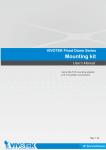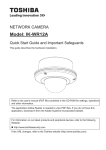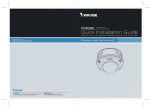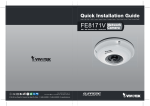Download Vivotek Network Camera FD7141(V) User`s manual
Transcript
FD7141(V) English Warning Before Installation Power off the Network Camera as soon as smoke or unusual odors are detected. Refer to your user's manual for the operating temperature. Contact your distributor in the event of occurrence. Do not place the Network Camera on unsteady surfaces. Do not touch the Network Camera during a lightning storm. Do not insert sharp or tiny objects into the Network Camera. Do not drop the Network Camera. EN - 1 1 Package Contents FD7141 (FD7141V) Bottom Base / Plastic Cover (FD7141V only) Power Adapter Alignment Sticker / Ceiling Hole Template Sticker Drill hole Ceiling Hole Template Sticker L-type Hex Key Wrench / RJ45 Female/Female Coupler / Slica Gel / Screws Quick Installation Guide / Warranty Card Software CD EN - 2 English 2 Physical Description Inner View f= 3.3~12 mm (FD7141 Lens) f= 9~22 mm (FD7141V Lens) Tilt Screw Lens Light Sensor IR LEDs SD Card Slot Pan Screw Reccessed Reset Button Status LED Image Adjustment Screw Focus Controller Zoom Controller N.C. N.C. N.C. V AC24 V AC24 General I/O Terminal Block Ethernet 10/100 RJ45 Plug Audio Out (green) Microphone In (pink) Power Cord Socket (black) Ground Fan The fan will operate when the temparature inside the Network Camera reaches over 50°C. EN - 3 Outer View Dome Cover N.C. N.C. N.C. AC24V AC24V Camera Base c b a Bottom Base c Record the MAC address under the camera base before installing the camera. Network Camera Model No: FD7141 RoHS V I MAC:0002D1083236 This device complies with part 15 of the FCC rules. Operation is subject to the following two conditions: (1)This device may not cause harmful interference, and (2) this device must accept any interference received, including interference that may cause undesired operation. Pat. 6,930,709 Made in Taiwan a Hole a~c: Holes for ceiling mount or for attaching the bottom base. b EN - 4 English 3 Hardware Installation First, use a screwdriver to loose the three screws and detach the dome cover from the camera base. Then, follow the steps below to install the camera to either a ceiling or a wall. N.C. N.C. N.C. AC24V AC24V Ceiling mount with the bottom base 1. Attach the supplied alignment sticker to the ceiling. 2. Using the 10 circles on the sticker, drill 2 pilot holes symmetrically on each side into the ceiling. Then hammer the four supplied plastic anchors into the holes. 3. Through the four holes on the bottom base, insert the four supplied screws into the corresponding holes and secure the bottom base with a screwdriver. 4. Feed the cables through hole A or B. If you want to use hole B, remove the rubber stopper with a screwdriver. 5. Secure the camera base to the bottom base with three supplied screws. A 1 2 4 B 3 EN - 5 5 Wall mount with the bottom base 1. Attach the supplied alignment sticker to the wall. 2. Using the 10 circles on the sticker, drill 2 pilot holes symmetrically on each side into the wall. Then hammer the four supplied plastic anchors into the holes. 3. Using the four holes on the bottom base, insert the four supplied screws to corresponding holes and secure the bottom base with a screwdriver. 4. Feed the cables through hole A or B. If you want to use hole B, remove the rubber stopper with a screwdriver. 5. Secure the camera base to the bottom base with three supplied screws. 1 3 2 4 B 5 EN - 6 A English Ceiling mount without the bottom base (Embedded) 1. Attach the supplied ceiling hole template sticker to the ceiling. 2. Open a hole along the inner circle of the sticker. 3. Using the 3 circles on the sticker, drill 3 pilot holes into the ceiling. Then hammer the three supplied plastic anchors into the holes. 4. Mount the Network Camera to the ceiling and feed the cables through. 5. Using the three holes on the side of the camera base, insert the three supplied screws into the corresponding holes and secure them with a screwdriver. 5 4 2 1 3 Drill hole Ceiling Hole Template Sticker 4 Network Deployment General Connection (without PoE) 1. If you have external devices such as sensors and alarms, make the connection from the general I/O terminal block. N.C. N.C. N.C. AC24V AC24V N.C.: N.C.: N.C.: AC24V: AC24V: No Connector No Connector No Connector Power in AC 24V Power in AC 24V GND DI DO +12V GND: DI : D O : +12V : Ground Digital Input Digital Output Power, 12V DC 2. Use the supplied RJ45 female/female coupler to connect the Network Camera to a switch. Use a Category 5 Cross Cable when Network Camera is directly connected to PC. POWER COLLISION 1 2 3 4 5 LINK RECEIVE PARTITION N.C. N.C. N.C. AC24V AC24V 3. Connect the power cable from the Network Camera to a power outlet. EN - 7 Power over Ethernet (PoE) When using a PoE-enabled switch The Network Camera is PoE-compliant, allowing transmission of power and data via a single Ethernet cable. Follow the below illustration to connect the Network Camera to a PoE-enabled switch via Ethernet cable. N.C. N.C. N.C. AC24V AC24V POWER COLLISION 1 2 3 4 5 LINK RECEIVE PARTITION PoE Switch When using a non-PoE switch Use a PoE power injector (optional) to connect between the Network Camera and a non-PoE switch. N.C. N.C. N.C. AC24V AC24V PoE Power Injector (optional) Non-PoE Switch POWER EN - 8 COLLISION 1 2 3 4 5 LINK RECEIVE PARTITION English 5 Assigning an IP Address 1. Install “Installation Wizard 2” from the Software Utility directory on the software CD. 2. The program will conduct an analysis of your network environment. After your network is analyzed, please click on the “Next” button to continue the program. Installation Wizard 2 3. The program will search for VIVOTEK Video Receivers, Video Servers, and Network Cameras on the same LAN. 4. After searching, the main installer window will pop up. Click on the MAC that matches the one labeled on the bottom of your device to connect to the Network Camera via Internet Explorer. Network Camera Model No: FD7141 RoHS V I 0002D1083236 MAC:0002D1083236 This device complies with part 15 of the FCC rules. Operation is subject to the following two conditions: (1)This device may not cause harmful interference, and (2) this device must accept any interference received, including interference that may cause undesired operation. Pat. 6,930,709 Made in Taiwan EN - 9 6 Ready to Use 1. Access the Network Camera on the LAN. 2. Retrieve live video through a web browser or recording software. http://192.168.5.109/index.html For further setup, please refer to the user's manual on the software CD. EN - 10 English 7 Adjusting the Lens Based on the live image retrieved from the camera, adjust the camera lens by doing the following: To adjust the viewing angle 1. Loosen the pan screw and then turn the lens module left and right. Upon completion, tighten the pan screw. 2. Loosen the tilt screws on both sides of the camera and turn the lens module up and down. Upon completion, tighten the tilt screws. 3. Loosen the image adjustment screw and then turn the lens to adjust the image orientation. Upon completion, tighten the image adjustment screw. Rotate the screw Turn the lens Loosen 1 Tighten Loosen Loosen 2 Pan 350° Tighten 3 Tighten Rotate 350° Tilt 95° To adjust the zoom factor and focus range 1. Loosen the zoom controller, then adjust zoom factor by moving the controller left and right. Upon completion, tighten the zoom controller. 2. Loosen the focus controller, then adjust focus range by moving the controller left and right. Upon completion, tighten the focus controller. Loosen W N DO NOT over tighten the controllers. Doing so will damage the camera lens module. EN - 11 8 Tighten T Note If you are using FD7141V (f= 9~22 mm), please hold the supplied plastic cover in front of the lens while adjusting the focus controller as shown below. axis of the lens 8 Completion Attach the dome cover to camera. Secure the three dome screws with the supplied screwdriver. Finally, make sure all parts of the camera are securely installed. EN - 12 P/N:625007701G Ver.1.1 Copyright c 2009 VIVOTEK INC. All rights reserved.























